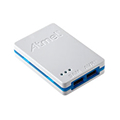Development systems boards and programmers include evaluation boards, starter kits, and external programming tools for flashing and debugging. They're crucial for fast bring-up, tighter firmware cycles, and lower risk between concept and production. Engineers get working I/O, power, and interfaces on day one, while purchasers gain predictable timelines. Online Components is an authorized distributor (established 1999) with reliable stock, U.S.-based inventory, and U.S.-based shipping that keeps projects moving with confidence.
The category spans MCU and FPGA boards, sensor and communications add-ons, power stages, and programmers using JTAG, SWD, ISP, and USB. Shoppers can filter by processor family, memory, clock speed, I/O count, voltage, package access, form factor, and IDE support.
How to Choose the Right Development Systems Boards & Programmers
Start with compatibility: match the target MCU or FPGA, voltage levels, pinout, and the required programming protocol (JTAG, SWD, or ISP). Next, review the toolchain and software ecosystem, including IDE support, RTOS options, board support packages, and library availability. Broad documentation and examples often cut ramp time. Finally, size the hardware features to your workload. Think analog performance, timers, communications such as SPI, I²C, UART, and Ethernet so prototypes behave like the finished device.
Popular Applications for Development Systems Boards & Programmers
Purchasers, design engineers, embedded developers, and test teams rely on these products for rapid proofs-of-concept, firmware bring-up, and production line programming. Industrial automation and control uses them for motor control, human-machine interfaces, and gateway logic. IoT and edge designs tap development boards for sensor fusion, wireless stacks, and battery-aware power design. Robotics and motion systems use real-time control, encoder input, and drive tuning, while education and research labs adopt them for coursework, labs, and hardware demonstrations.
Why Buy Development Systems Boards & Programmers from Online Components?
Online Components keeps U.S.-based inventory ready for quick turn, with fast shipping on in-stock items to keep schedules on track. As an authorized source, products arrive through supplier authentication and traceable sourcing. Ordering is simple, pricing is competitive, and responsive customer service helps resolve technical or purchasing questions without friction. Buy now to equip your bench with the right development system and keep builds moving.
Development Systems Boards & Programmers: What You Need to Know
What's the difference between a development board and an evaluation board?
A development board targets rapid prototyping with headers, power options, and general-purpose I/O for building and testing application code. An evaluation board focuses on demonstrating a specific integrated circuit in a reference design, exposing key performance points. Many teams use both: evaluation to validate the silicon, development to finish the product.
Programmer vs. bootloader: when do I need hardware tools?
A hardware programmer or debug probe speaks JTAG or SWD for full-chip access, breakpoint stepping, and recovery from bad images. A bootloader relies on resident firmware, often over USB or UART, and can fail if flash contents are corrupted. For production reliability and low-level debug, a dedicated programmer is the safer path.
Which interfaces matter for debugging and expansion?
For debug, JTAG and SWD dominate. Confirm connector style and pinout. For expansion, check SPI, I²C, UART, and Ethernet, plus available headers or castellated pads. Matching voltage levels and current capability avoids brownouts and flaky signals.
Do these boards work with open-source tools?
Many support GCC, CMake builds, and OpenOCD, along with vendor IDEs. Confirm device support files, debug configurations, and example projects so your team can build, flash, and step code on day one.
contáctenos
 English
English
 Chinese
Chinese
 Italiano
Italiano
 Portuguese
Portuguese
 Deutschland
Deutschland
 French
French
 Russian
Russian
 Japanese
Japanese
 Turkish
Turkish
 Korean
Korean
 Spanish
Spanish









